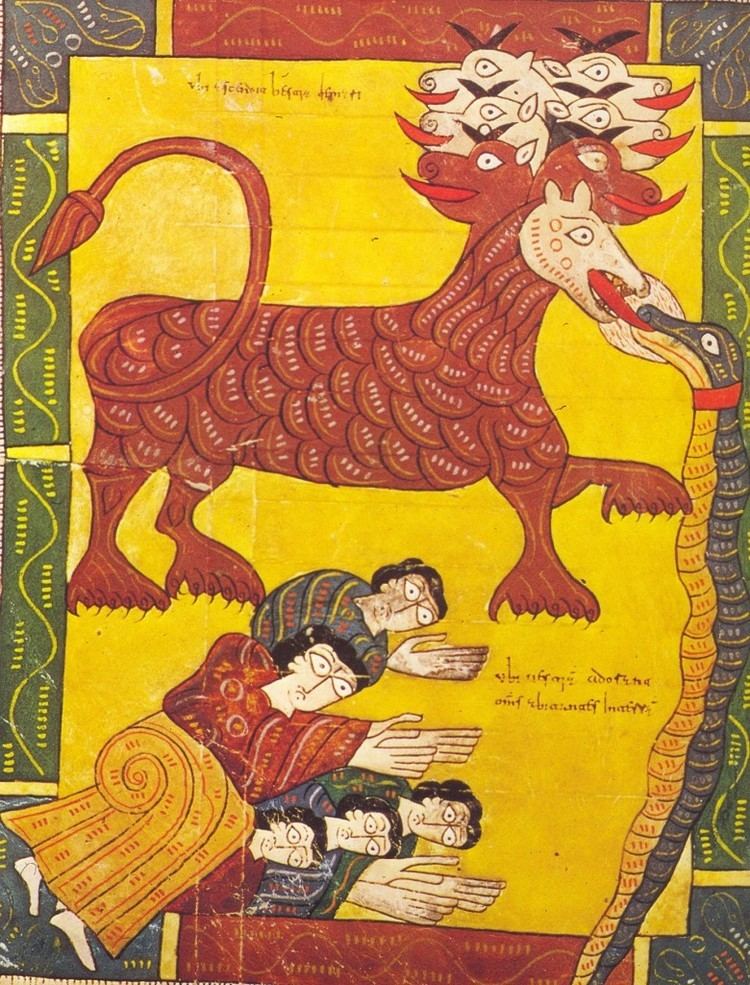 | ||
Similar Etymologiae, Bamberg Apocalypse, Book of Durrow, Lindisfarne Gospels, Horae Apocalypticae | ||
Commentary on the Apocalypse (Commentaria In Apocalypsin) is a book written in the eighth century by the Spanish monk and theologian Beatus of Liébana (730–785) and copied and illustrated in manuscipt in works called "Beati" during the 10th and 11th Centuries a.d. It is a commentary on the New Testament Apocalypse of John or Book of Revelation. It also refers to any manuscript copy of this work, especially any of the 27 illuminated copies that have survived. It is often referred to simply as the Beatus. The historical significance of the Commentary is made even more pronounced since it included a world map, which offers a rare insight into the geographical understanding of the post-Roman world. Well-known copies include the Morgan, the Saint-Sever, the Gerona, the Osma and the Madrid (Vitr 14-1) Beatus codices.
Contents
- The Commentary on the Apocalypse Commentaria In Apocalypsin
- The message
- Copies of the manuscript
- 12th Century and 13th Century
- Not illustrated
- Copied in South Italy
- Copied in Southwestern France
- References
Considered together, the Beatus codices are among the most important Spanish manuscripts and have been the subject of extensive scholarly and antiquarian enquiry. The illuminated versions now represent the best known works of Mozarabic art, and had some influence on the medieval art of the rest of Europe.
The Commentary on the Apocalypse (Commentaria In Apocalypsin)
The work consists of several prologues (which differ among the manuscripts) and one long summary section (the "Summa Dicendum") before the first book, an introduction to the second book, and 12 books of commentary, some long and some very short. Beatus states in its dedication to his friend Bishop Etherius that it is meant to educate his brother monks.
The work is structured around selections from previous Apocalypse commentaries and references by Ticonius (now mostly lost), St. Primasius of Hadrumentum, St. Caesarius of Arles, St. Apringius of Beja, and many others. There are also long extracts from the texts of the Fathers of the Church and Doctors of the Church, especially Augustine of Hippo, Ambrose of Milan, Irenaeus of Lyons, Pope Gregory I, Saint Jerome of Stridon, and Isidore of Seville. Some manuscripts add commentaries on the books of Ezekiel and Daniel by other authors, genealogical tables, and the like, but these are not strictly part of the Beatus.
The creative character of the Commentary comes from Beatus' writing of a wide-ranging catena of verses from nearly every book of the Bible, quotes of patristic commentary from many little known sources, and interstitial original comments by Beatus. His attitude is one of realism about church politics and human pettiness, hope and love towards everyday life even when it is difficult, and many homely similes from his own time and place. (For example, he compares evangelization to lighting fires for survival when caught far from home by a sudden mountain blizzard, and the Church to a Visigothic army with both generals and muleskinners.) His work is also a fruitful source for Spanish linguistics, as Beatus often alters words in his African Latin sources to the preferred synonyms in Hispanic Latin.
The message
The Kingdom of Toledo fell in 711, leaving most of the Iberian Peninsula in the hands of Muslim conquerors. Christians under Peylayo managed to establish one kingdom on the northern coast, protected by the Cantabrian Mountains. Beautus lived in the Cantabrian valley of Liébana. With the recent conquest of the Iberian Peninsula, the Apocalypse and the symbolism in it took on a different meaning. The beast, which had previously been believed to represent the Roman Empire, now became the Caliphate, and Babylon was no longer Rome, but Córdoba.
In continuity with previous commentaries written in the Tyconian tradition, and in continuity with St. Isidore of Seville and St. Apringius of Beja from just a few centuries before him, Beatus' Commentary on the Apocalypse focuses on the sinless beauty of the eternal Church, and on the tares growing among the wheat in the Church on Earth. Persecution from outside forces like pagan kings and heretics is mentioned, but it is persecution from fellow members of the Church that Beatus spends hundreds of pages. Anything critical of the Jews in the Bible is specifically said to have contemporary effect as a criticism of Christians, and particularly of monks and other religious; and a good deal of what is said about pagans is stated as meant as a criticism of Christians who worship their own interests more than God. Muslims are barely mentioned, except as references to Christian heresies include them. Revelation is a book about the Church's problems throughout all ages, not about history per se. In the middle of Book 4 of 12, Beatus does state his guess about the end-date of the world (801 AD, from the number of the Holy Spirit plus Alpha, as well as a few other calculations) although he warns people that it is folly to try to guess a date that even Jesus in the Bible claimed not to know.
Copies of the manuscript
There are 35 surviving copies, 27 of which are illustrated:
12th Century and 13th Century
'*Beatus of Navarra. (Beatus of Liébana - Navarra Codex). Ca. 12th Century, 60 illuminations. Kept at Bibliothèque Nationale de France, Paris. Ms. Nouv. Acq. Lat. 1366
